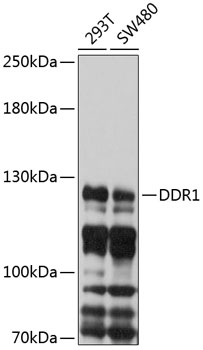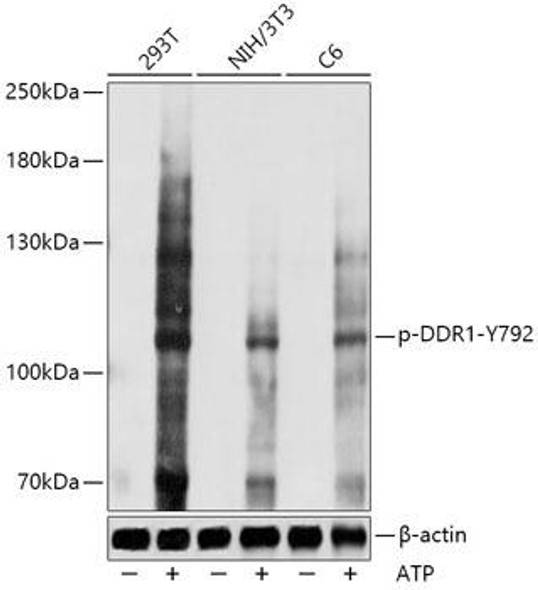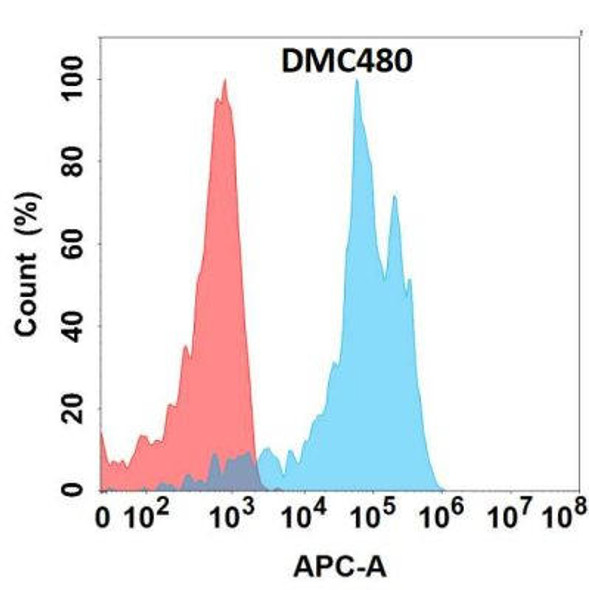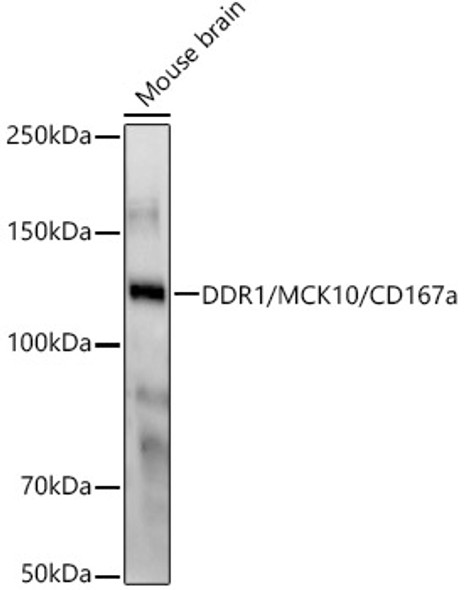Cell Biology Antibodies 1
Anti-DDR1 Antibody (CAB10487)
- SKU:
- CAB10487
- Product Type:
- Antibody
- Reactivity:
- Human
- Host Species:
- Rabbit
- Isotype:
- IgG
- Antibody Type:
- Polyclonal Antibody
- Research Area:
- Cell Biology
Description
| Antibody Name: | Anti-DDR1 Antibody |
| Antibody SKU: | CAB10487 |
| Antibody Size: | 20uL, 50uL, 100uL |
| Application: | WB |
| Reactivity: | Human |
| Host Species: | Rabbit |
| Immunogen: | Recombinant fusion protein containing a sequence corresponding to amino acids 290-420 of human DDR1 (NP_054700.2). |
| Application: | WB |
| Recommended Dilution: | WB 1:1000 - 1:2000 |
| Reactivity: | Human |
| Positive Samples: | 293T, SW480 |
| Immunogen: | Recombinant fusion protein containing a sequence corresponding to amino acids 290-420 of human DDR1 (NP_054700.2). |
| Purification Method: | Affinity purification |
| Storage Buffer: | Store at -20'C. Avoid freeze / thaw cycles. Buffer: PBS with 0.02% sodium azide, 50% glycerol, pH7.3. |
| Isotype: | IgG |
| Sequence: | MHTL GARL PGGV ECRF RRGP AMAW EGEP MRHN LGGN LGDP RARA VSVP LGGR VARF LQCR FLFA GPWL LFSE ISFI SDVV NNSS PALG GTFP PAPW WPPG PPPT NFSS LELE PRGQ QPVA KAEG SPTA ILI |
| Gene ID: | 780 |
| Uniprot: | Q08345 |
| Cellular Location: | Cell membrane, Secreted, Single-pass type I membrane protein |
| Calculated MW: | 27kDa/97kDa/99kDa/101kDa |
| Observed MW: | 125kDa |
| Synonyms: | CAK, CD167, DDR, EDDR1, HGK2, MCK10, NEP, NTRK4, PTK3, PTK3A, RTK6, TRKE, DDR1 |
| Background: | Receptor tyrosine kinases play a key role in the communication of cells with their microenvironment. These kinases are involved in the regulation of cell growth, differentiation and metabolism. The protein encoded by this gene belongs to a subfamily of tyrosine kinase receptors with homology to Dictyostelium discoideum protein discoidin I in their extracellular domain, and that are activated by various types of collagen. Expression of this protein is restricted to epithelial cells, particularly in the kidney, lung, gastrointestinal tract, and brain. In addition, it has been shown to be significantly overexpressed in several human tumors. Alternatively spliced transcript variants encoding different isoforms have been described for this gene. |
| UniProt Protein Function: | DDR1: Tyrosine kinase that functions as cell surface receptor for fibrillar collagen and regulates cell attachment to the extracellular matrix, remodeling of the extracellular matrix, cell migration, differentiation, survival and cell proliferation. Collagen binding triggers a signaling pathway that involves SRC and leads to the activation of MAP kinases. Regulates remodeling of the extracellular matrix by up-regulation of the matrix metalloproteinases MMP2, MMP7 and MMP9, and thereby facilitates cell migration and wound healing. Required for normal blastocyst implantation during pregnancy, for normal mammary gland differentiation and normal lactation. Required for normal ear morphology and normal hearing. Promotes smooth muscle cell migration, and thereby contributes to arterial wound healing. Also plays a role in tumor cell invasion. Phosphorylates PTPN11. Interacts (via PPxY motif) with WWC1 (via WW domains) in a collagen-regulated manner. Forms a tripartite complex with WWC1 and PRKCZ, but predominantly in the absence of collagen. Interacts (tyrosine phosphorylated) with SHC1. Interacts with SRC. Interacts with MYH9. Interacts with CDH1. Interacts with PTPN11. Interacts with NCK2. Detected in T-47D, MDA-MB-175 and HBL-100 breast carcinoma cells, A-431 epidermoid carcinoma cells, SW48 and SNU-C2B colon carcinoma cells and Hs 294T melanoma cells. Expressed at low levels in most adult tissues and is highest in the brain, lung, placenta and kidney. Lower levels of expression are detected in melanocytes, heart, liver, skeletal muscle and pancreas. Abundant in breast carcinoma cell lines. In the colonic mucosa, expressed in epithelia but not in the connective tissue of the lamina propria. In the thyroid gland, expressed in the epithelium of the thyroid follicles. In pancreas, expressed in the islets of Langerhans cells, but not in the surrounding epithelial cells of the exocrine pancreas. In kidney, expressed in the epithelia of the distal tubules. Not expressed in connective tissue, endothelial cells, adipose tissue, muscle cells or cells of hematopoietic origin. Belongs to the protein kinase superfamily. Tyr protein kinase family. Insulin receptor subfamily. 5 isoforms of the human protein are produced by alternative splicing. |
| UniProt Protein Details: | Protein type:EC 2.7.10.1; Membrane protein, integral; Protein kinase, TK; Kinase, protein; Protein kinase, tyrosine (receptor); TK group; DDR family Chromosomal Location of Human Ortholog: 6p21.3 Cellular Component: extracellular space; plasma membrane; receptor complex Molecular Function:collagen binding; protein binding; transmembrane receptor protein tyrosine kinase activity Biological Process: cell adhesion; extracellular matrix organization and biogenesis; protein amino acid autophosphorylation; smooth muscle cell migration |
| NCBI Summary: | Receptor tyrosine kinases play a key role in the communication of cells with their microenvironment. These kinases are involved in the regulation of cell growth, differentiation and metabolism. The protein encoded by this gene belongs to a subfamily of tyrosine kinase receptors with homology to Dictyostelium discoideum protein discoidin I in their extracellular domain, and that are activated by various types of collagen. Expression of this protein is restricted to epithelial cells, particularly in the kidney, lung, gastrointestinal tract, and brain. In addition, it has been shown to be significantly overexpressed in several human tumors. Alternatively spliced transcript variants encoding different isoforms have been described for this gene. [provided by RefSeq, Feb 2011] |
| UniProt Code: | Q08345 |
| NCBI GenInfo Identifier: | 729008 |
| NCBI Gene ID: | 780 |
| NCBI Accession: | Q08345.1 |
| UniProt Secondary Accession: | Q08345,Q14196, Q16562, Q2L6H3, Q4LE50, Q5ST11, Q5ST12 Q6NSK4, Q9UD35, B5A975, B5A976, B7Z2K0, |
| UniProt Related Accession: | Q08345 |
| Molecular Weight: | 99,064 Da |
| NCBI Full Name: | Epithelial discoidin domain-containing receptor 1 |
| NCBI Synonym Full Names: | discoidin domain receptor tyrosine kinase 1 |
| NCBI Official Symbol: | DDR1 |
| NCBI Official Synonym Symbols: | CAK; DDR; NEP; HGK2; PTK3; RTK6; TRKE; CD167; EDDR1; MCK10; NTRK4; PTK3A |
| NCBI Protein Information: | epithelial discoidin domain-containing receptor 1 |
| UniProt Protein Name: | Epithelial discoidin domain-containing receptor 1 |
| UniProt Synonym Protein Names: | CD167 antigen-like family member A; Cell adhesion kinase; Discoidin receptor tyrosine kinase; HGK2; Mammary carcinoma kinase 10; MCK-10; Protein-tyrosine kinase 3A; Protein-tyrosine kinase RTK-6; TRK E; Tyrosine kinase DDR; Tyrosine-protein kinase CAK; CD_antigen: CD167a |
| Protein Family: | Epithelial discoidin domain-containing receptor |
| UniProt Gene Name: | DDR1 |
| UniProt Entry Name: | DDR1_HUMAN |
View AllClose







